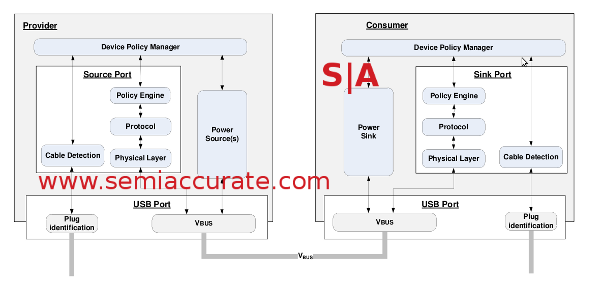 At long last, the USB 3.0 Promoter Group has approved the Power Delivery spec for up to 100W over a USB cable. Not to be outdone, the USB 2.0 Promoter Group approved it too.
At long last, the USB 3.0 Promoter Group has approved the Power Delivery spec for up to 100W over a USB cable. Not to be outdone, the USB 2.0 Promoter Group approved it too.
The short story is that Power Delivery, aka PD, is an addition to USB 2/3, and is backwards compatible with the older specs. Because it would be a tad risky to push 100W over a cheap no-name cable, the spec also includes an intelligent check of both the cable and the other end’s capabilities. With careful planning, not luck, there won’t be any ‘whoopsies’ that involve smoke, flame, or other things that are funnier when they happen to someone else.
Power Deliver as you might guess is not a simple spec. PD can send power both ways intelligently, ramp delivery up or down, work with both BC1.2 (Battery Charge 1.2, the current power to device spec) and do all this intelligently. How? Magic. And careful engineering, making sure devices meet the specs, and giving them a logo so consumers can see that they will work right when passing enough to light 100W bulb.
USB PD logos
There are a few pieces that you should probably know about, the Power Source, Power Sink, Device Policy Manager, Source Port, and Sink Port. Power Source and PowerSink are the side that sends power, and the side that receives power respectively. The ports with the same prefix are the ports that also send and receive power, all controlled by the Device Policy Manager (DPM). In case it wasn’t obvious, the DPM is the brains of the whole scheme, and does what it sounds like, controls the device’s power in, out, or both.
The diagram of the architecture
One thing to keep in mind is that you usually have a device that is a source feeding a sink, imagine a laptop charging a portable battery. If the laptop is plugged in, the power goes from the laptop to the battery as you would expect. When you unplug the laptop, the laptop can signal the device to either stop pulling power, take less power, more if that is the intent, or somewhat counter-intuitively, pull power from the device it was just charging.
This allows some very interesting possibilities, the most intriguing is getting rid of charging ports entirely, and having every USB port, with PD support of course, capable of powering the laptop. Or powering another laptop, monitor, or anything else. Or none of the above, and not catch fire while doing any of it, quite a trick when you are talking about pushing 100W over a thin USB cable.
Much of this is possible because the PD spec requires and detects PD cables, both their presence and whether they are normal or micro-USB connectors. Why? PD specs 5A over the wire safely for full sized PD cables and connectors, 3A for micro-USB PD cables. If you are math capable, you might have noticed that to get 100W with 5A, you need to have 20V.
That would indeed be the case, PD specifies, but does not require absolutely sticking to, six profiles for power. The intent is to deliver between 10W and 100W in steps that roughly double the one before. These six profiles are cleverly named Profile 0-5, with 0 being reserved.
Profile 1 is 2A@5V or 10W, roughly what Gigabyte delivers now on their 3X power boards. From there, Profile 2 is 5V@2A or 12V@1.5A, Profile 3 is 5V@2A or 12V@3A, Profile 4 adds 20V@3A to it’s predecessor, and Profile 5 bumps the 12V and 20V to the full 5A. We hear that the real reason Profile 0 is reserved is because Apple kept vetoing the PD-AJS (PD-Auto Jump Start) addendum for fear of their precious cables getting dirty in public. The USB Promoter Group will not confirm or deny whether this was the case.
In any case, that is USB PD in a nutshell. It can ramp power up or down between profiles on the fly, and switch direction of power flow too. PD will detect and utilize current USB cables, and deliver up to 100W over newer PD spec cables. The result is the long over due delivery of real amperage over USB. Take that Dark Peak.S|A
Charlie Demerjian
Latest posts by Charlie Demerjian (see all)
- Qualcomm Is Cheating On Their Snapdragon X Elite/Pro Benchmarks - Apr 24, 2024
- What is Qualcomm’s Purwa/X Pro SoC? - Apr 19, 2024
- Intel Announces their NXE: 5000 High NA EUV Tool - Apr 18, 2024
- AMD outs MI300 plans… sort of - Apr 11, 2024
- Qualcomm is planning a lot of Nuvia/X-Elite announcements - Mar 25, 2024

